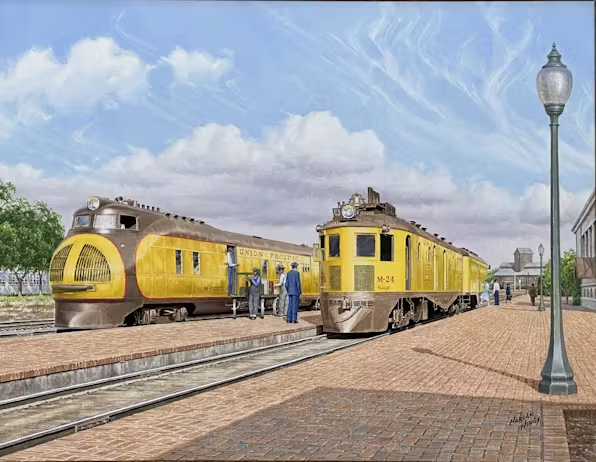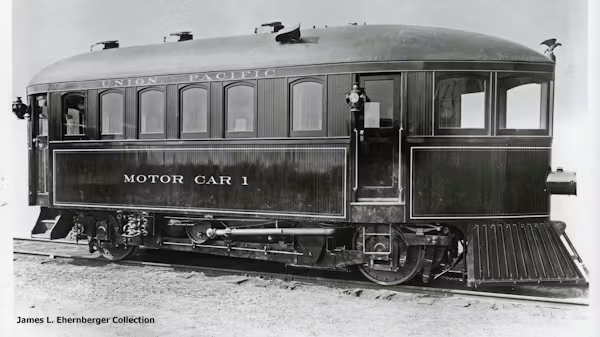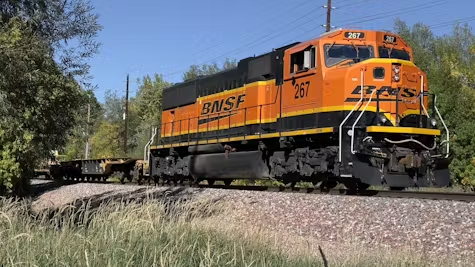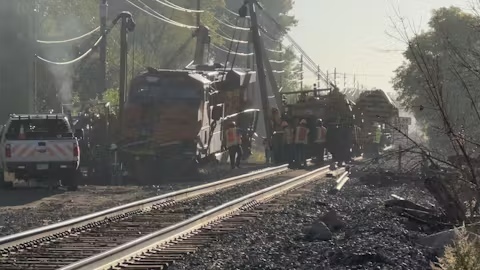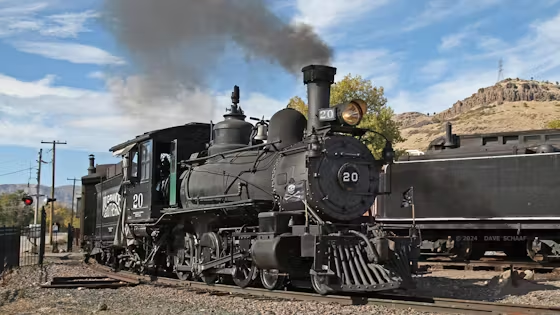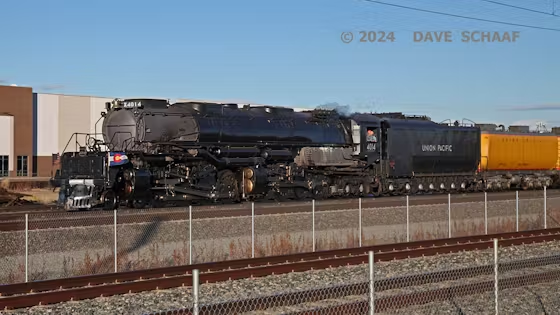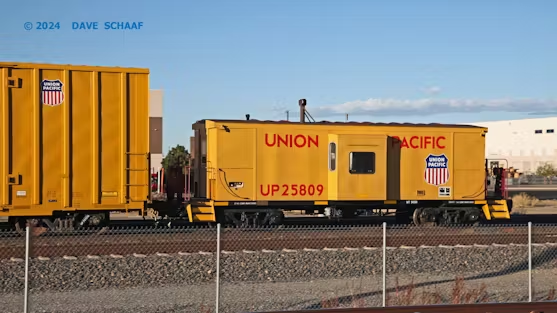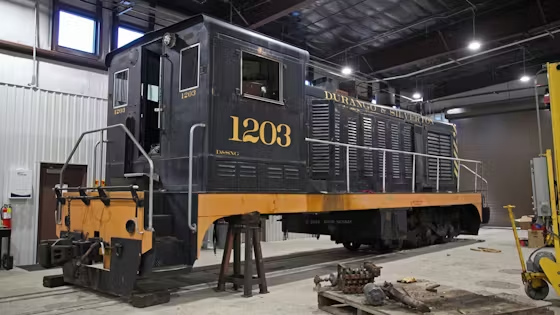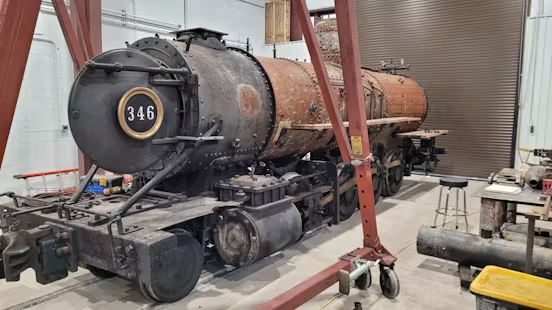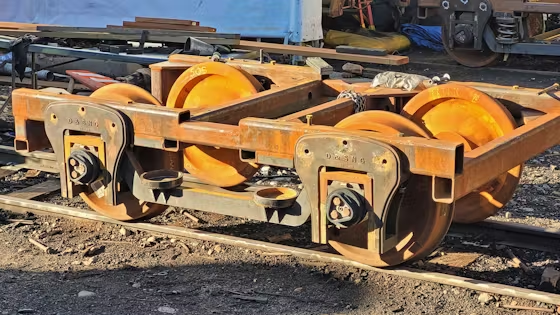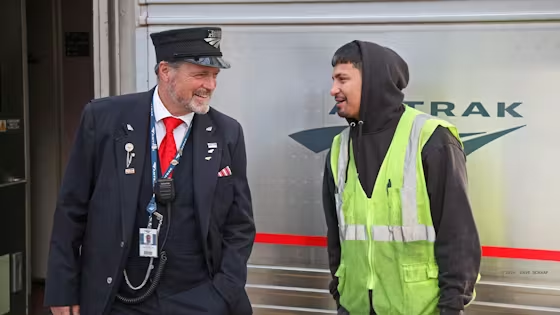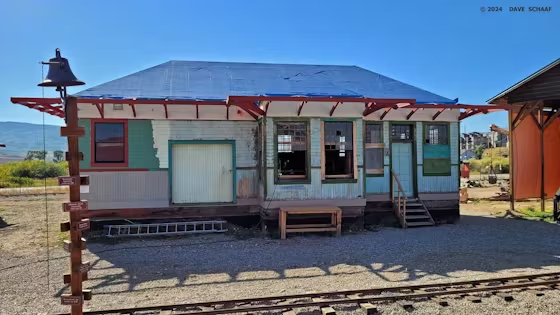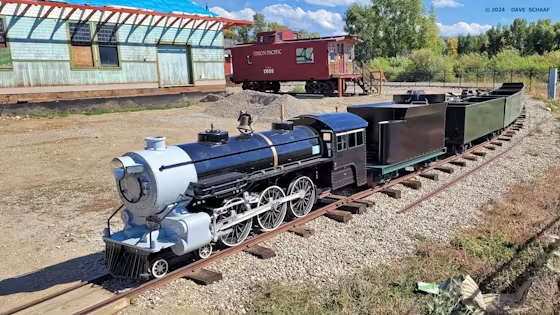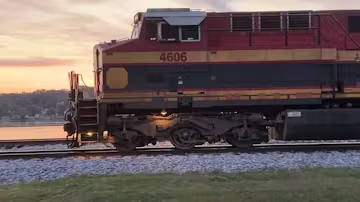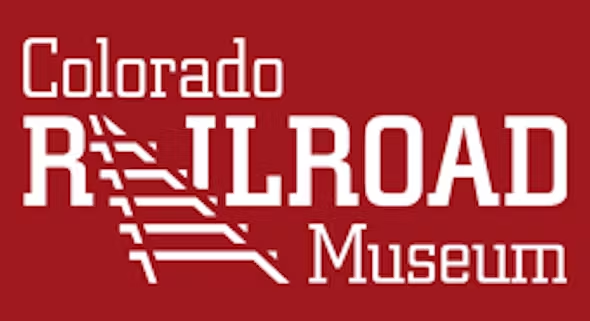--- November 12 meeting at Barnes Hall --- |
--- November 12 meeting at Barnes Hall --- |
W. R. McKEEN AND UNION PACIFIC MOTOR CARS Program by Jim Ehernberger |
W. R. McKEEN AND UNION PACIFIC MOTOR CARS Program by Jim Ehernberger |
In 1905, the Omaha Union Pacific Shops built the first gasoline rail
motor car. Mr. E. H. Harriman assigned the project to William R.
McKeen, the Mechanical Superintendent of the railroad, to build a
gasoline powered vehicle to replace steam trains and equipment on many
U.P. branch lines to cut costs. A
steam locomotive required fourteen tons of fuel and 7,000 gallons of
water, while the motor car could run the same distance and required only
fifty gallons of gasoline. The
original (prototype) car was 31 feet in length and could handle 25
passengers. They were known as McKeen Cars, and the motor was
positioned providing a chain drive to the leading axle. Subsequent
cars were made available at 55 feet or 70 feet in length, and were
modified based on what service was required with baggage, express, mail
and passenger compartments, and traveled over nearly every state the
Union Pacific operated in. Their pointed nose and round windows
became the unique features of the 160 cars that were constructed and
sold to numerous railroads in America, Australia and Cuba. The
final McKeen Car in Colorado operated from Denver to Boulder, making
its last run on October 31, 1941. For a short duration in 1952, a
more modern gas-electric car was used between Denver and Cheyenne, but
the passenger cars attached to it created a problem maintaining the
schedule, and steam power returned on that run. On
December 31, 1955, the final motor car trip within Nebraska was made,
between Kearney and Stapleton, on the Kearney branch, signifying over 50
years of motor car service dating back to August 21, 1905. The
final motor car operation on the entire Union Pacific was on the
Plainville (Kansas) branch line ending on May 31, 1958. Two images above from the collection of James L. Ehernberger. |
In 1905, the Omaha Union Pacific Shops built the first gasoline rail
motor car. Mr. E. H. Harriman assigned the project to William R.
McKeen, the Mechanical Superintendent of the railroad, to build a
gasoline powered vehicle to replace steam trains and equipment on many
U.P. branch lines to cut costs. A
steam locomotive required fourteen tons of fuel and 7,000 gallons of
water, while the motor car could run the same distance and required only
fifty gallons of gasoline. The
original (prototype) car was 31 feet in length and could handle 25
passengers. They were known as McKeen Cars, and the motor was
positioned providing a chain drive to the leading axle. Subsequent
cars were made available at 55 feet or 70 feet in length, and were
modified based on what service was required with baggage, express, mail
and passenger compartments, and traveled over nearly every state the
Union Pacific operated in. Their pointed nose and round windows
became the unique features of the 160 cars that were constructed and
sold to numerous railroads in America, Australia and Cuba. The
final McKeen Car in Colorado operated from Denver to Boulder, making
its last run on October 31, 1941. For a short duration in 1952, a
more modern gas-electric car was used between Denver and Cheyenne, but
the passenger cars attached to it created a problem maintaining the
schedule, and steam power returned on that run. On
December 31, 1955, the final motor car trip within Nebraska was made,
between Kearney and Stapleton, on the Kearney branch, signifying over 50
years of motor car service dating back to August 21, 1905. The
final motor car operation on the entire Union Pacific was on the
Plainville (Kansas) branch line ending on May 31, 1958. Two images above from the collection of James L. Ehernberger. |
|
|
| Upcoming meeting event at Barnes Hall Rich Luckin's new video program on December 10th, Ski Train. At this meeting will also be the annual Club election as well as cookies and soft drinks. |
Upcoming meeting event at Barnes Hall Rich Luckin's new video program on December 10th, Ski Train. At this meeting will also be the annual Club election as well as cookies and soft drinks. |
Nominating Committee Update The
nominating committee has been identifying members willing to serve for
the 2025 year. The following slate of officers are being presented to
the membership for 2025. The election will take place at the annual
meeting on December 10, 2024. OFFICERS: President - Dave Goss Vice President - Dave Schaaf Treasurer - Keith Jensen Secretary - Steve Subber BOARD MEMBERS: Andy Dell Jean Gross Denny Leonard Pete West Returning Board Members Serving the Second of Their Two-year Term: Jim Ehernberger Andrew Ludasi Debbie MacDonald Kirk Thode Nathan Zachman Membership Renewals for 2025 It
is that time of year again when we begin the membership renewal
process. This week I will be mailing out the renewal forms by mail. We
find we get a better response when a form is physically mailed to remind
everyone to renew. You may either pay by PayPal on the club website at https://www.rockymtnrrclub.org/membersp.htm or by mailing in the form you receive in the mail with a check to Rocky Mountain Railroad Club
Attn: Membership
P.O. Box 551 Westminster, Colorado 80036-0551 IMPORTANT! Please note that we have a new P.O. Box for membership renewals this year. You can also print the membership form online and mail it to the above address with your check. https://www.rockymtnrrclub.org/member.htm |
Nominating Committee Update The
nominating committee has been identifying members willing to serve for
the 2025 year. The following slate of officers are being presented to
the membership for 2025. The election will take place at the annual
meeting on December 10, 2024. OFFICERS: President - Dave Goss Vice President - Dave Schaaf Treasurer - Keith Jensen Secretary - Steve Subber BOARD MEMBERS: Andy Dell Jean Gross Denny Leonard Pete West Returning Board Members Serving the Second of Their Two-year Term: Jim Ehernberger Andrew Ludasi Debbie MacDonald Kirk Thode Nathan Zachman Membership Renewals for 2025 It
is that time of year again when we begin the membership renewal
process. This week I will be mailing out the renewal forms by mail. We
find we get a better response when a form is physically mailed to remind
everyone to renew. You may either pay by PayPal on the club website at https://www.rockymtnrrclub.org/membersp.htm or by mailing in the form you receive in the mail with a check to Rocky Mountain Railroad Club
Attn: Membership
P.O. Box 551 Westminster, Colorado 80036-0551 IMPORTANT! Please note that we have a new P.O. Box for membership renewals this year. You can also print the membership form online and mail it to the above address with your check. https://www.rockymtnrrclub.org/member.htm |
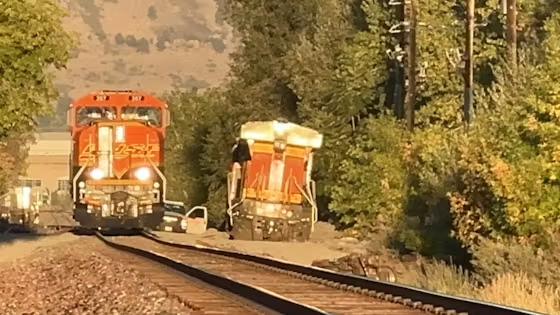 |
BNSF
267, an EMD SD75M, arrived at Boulder, Colorado, October 2, 2024, to
assist in removal of derailment damaged BNSF 4272. Back on August
25, 2024, a southbound BNSF train collided with skeleton intermodal cars
that had been stored on Boulder Siding and had rolled out onto the main
track. ©2024 Chip |
BNSF
267, an EMD SD75M, arrived at Boulder, Colorado, October 2, 2024, to
assist in removal of derailment damaged BNSF 4272. Back on August
25, 2024, a southbound BNSF train collided with skeleton intermodal cars
that had been stored on Boulder Siding and had rolled out onto the main
track. ©2024 Chip |
BNSF
and Hulcher (derailment clean up experts) were at South Boulder,
Colorado, to load derailment damaged BNSF 4272 onto a heavy duty flatcar
on October 2, 2024. Four Hulcher side booms lifted the locomotive
without its trucks onto QTTX 131268, a heavy duty flatcar. The
operation took place by the rebuilt Boulder Creek railroad bridge that
was destroyed during the August 25, 2024 derailment. The
derailment site was located just north of the Foothills Hospital and
BAE complex. BNSF wrapped up clearing the derailed equipment with
the help of Hulcher in early October 2024. |
BNSF
and Hulcher (derailment clean up experts) were at South Boulder,
Colorado, to load derailment damaged BNSF 4272 onto a heavy duty flatcar
on October 2, 2024. Four Hulcher side booms lifted the locomotive
without its trucks onto QTTX 131268, a heavy duty flatcar. The
operation took place by the rebuilt Boulder Creek railroad bridge that
was destroyed during the August 25, 2024 derailment. The
derailment site was located just north of the Foothills Hospital and
BAE complex. BNSF wrapped up clearing the derailed equipment with
the help of Hulcher in early October 2024. |
BNSF
267, an SD75M, was the power for the two flatcar train sent to retrieve
derailed BNSF 4272 at Boulder, Colorado, on October 2, 2024. Crew
was on duty at Denver, CO, at 5:00 AM to handle this special train.
©2024 Chip |
BNSF
267, an SD75M, was the power for the two flatcar train sent to retrieve
derailed BNSF 4272 at Boulder, Colorado, on October 2, 2024. Crew
was on duty at Denver, CO, at 5:00 AM to handle this special train.
©2024 Chip |
BNSF
4272 was lifted by Hulcher side booms on October 2, 2024. Wreck
recovery train was holding on the main with QTTX 131268 heavy duty
flatcar. Derailment happened on August 25, 2024. ©2024 Chip |
BNSF
4272 was lifted by Hulcher side booms on October 2, 2024. Wreck
recovery train was holding on the main with QTTX 131268 heavy duty
flatcar. Derailment happened on August 25, 2024. ©2024 Chip |
Rio
Grande Southern #20 pulled trains at the Colorado Railroad Museum on
October 19-20. This engine had been owned by the Rocky Mtn. RR
Club for over 50 years, and was displayed at the museum for most of that
time. Image © 2024 by Dave Schaaf. |
Rio
Grande Southern #20 pulled trains at the Colorado Railroad Museum on
October 19-20. This engine had been owned by the Rocky Mtn. RR
Club for over 50 years, and was displayed at the museum for most of that
time. Image © 2024 by Dave Schaaf. |
Union
Pacific's Big Boy locomotive arrived in Denver on October 21. The
engine and crew were in town for two nights, and then steamed north to
Cheyenne, Wyoming. This view is west of Havana Street, with #4014
westbound along Smith Road. Image © 2024 by Dave Schaaf |
Union
Pacific's Big Boy locomotive arrived in Denver on October 21. The
engine and crew were in town for two nights, and then steamed north to
Cheyenne, Wyoming. This view is west of Havana Street, with #4014
westbound along Smith Road. Image © 2024 by Dave Schaaf |
This bay window caboose brought up the rear of the steam special. Image © 2024 by Dave Schaaf. |
This bay window caboose brought up the rear of the steam special. Image © 2024 by Dave Schaaf. |
A
new shop building has been erected at the Durango yard in
Colorado. In September, this 1946 Porter diesel #1203 was having
some work done out of the weather. This Durango & Silverton
loco has previously been at several narrow gauge operations, including
Sumpter Valley and the Georgetown Loop. Image © 2024 by Dave
Schaaf. |
A
new shop building has been erected at the Durango yard in
Colorado. In September, this 1946 Porter diesel #1203 was having
some work done out of the weather. This Durango & Silverton
loco has previously been at several narrow gauge operations, including
Sumpter Valley and the Georgetown Loop. Image © 2024 by Dave
Schaaf. |
D&RGW
narrow gauge engine #346 is also in this new shop space in
Durango. Boiler and running gear work is being done for the
Colorado Railroad Museum. The tender and cab are not with the
loco, and it will not likely be test-run on the Silverton line.
Image © 2024 by Dave Schaaf. |
D&RGW
narrow gauge engine #346 is also in this new shop space in
Durango. Boiler and running gear work is being done for the
Colorado Railroad Museum. The tender and cab are not with the
loco, and it will not likely be test-run on the Silverton line.
Image © 2024 by Dave Schaaf. |
New
narrow-gauge trucks with roller bearings are being built at the Durango
& Silverton shops. © 2024 by Dave Schaaf |
New
narrow-gauge trucks with roller bearings are being built at the Durango
& Silverton shops. © 2024 by Dave Schaaf |
Amtrak
senior conductor Brad Swartzwelter retired in early October after 30
years. He is seen here at Denver Union Station just moments before
leaving on his last westbound train #5 to Grand Junction. Brad
gave a program at a Club meeting a couple of years ago. © 2024 by
Dave Schaaf. |
Amtrak
senior conductor Brad Swartzwelter retired in early October after 30
years. He is seen here at Denver Union Station just moments before
leaving on his last westbound train #5 to Grand Junction. Brad
gave a program at a Club meeting a couple of years ago. © 2024 by
Dave Schaaf. |
This
depot was moved in 2023 from Dumont, Colorado. This was on the
narrow gauge Colorado & Southern line in Clear Creek canyon, between
Idaho Springs and Georgetown. It now resides and is being
refurbished at the Moffat Road RR Museum near the Amtrak station in
Granby, Colorado. Image © 2024 by Dave Schaaf. |
This
depot was moved in 2023 from Dumont, Colorado. This was on the
narrow gauge Colorado & Southern line in Clear Creek canyon, between
Idaho Springs and Georgetown. It now resides and is being
refurbished at the Moffat Road RR Museum near the Amtrak station in
Granby, Colorado. Image © 2024 by Dave Schaaf. |
Also
new to Granby is the Family Train Ride at the Moffat Road RR
Museum. Plans are to have it operating in 2025. The former
C&S Dumont depot is shown in the background at left. © 2024
Dave Schaaf. - - - - |
Also
new to Granby is the Family Train Ride at the Moffat Road RR
Museum. Plans are to have it operating in 2025. The former
C&S Dumont depot is shown in the background at left. © 2024
Dave Schaaf. - - - - |
Alpine Tunnel Wall Reconstruction |
Alpine Tunnel Wall Reconstruction |
The
purpose of the closure during summer 2024 was to protect public safety
during the Alpine Tunnel Road and Palisade Wall Repair reconstruction
activities.
The closure region includes:
• National Forest System Road (NFSR) #839 – Alpine Tunnel Road
• National Forest System Trail (NFST) #298 – Williams Pass Jeep trail
• Lands above and below NFSR #839, progressing
south along the closed corridor surrounding NFSR #839 and continuing
south to NFST #888
• NFSR #767.1B (also known as NFS road 7767.1B)
• NFST #888
• NFST #539
•
St. Elmo to Pitkin — Alternate routes include traveling via
Hancock Pass to Tomichi Pass to Black Sage Pass to Waunita Pass or via
Tin Cup Pass to Cumberland Pass. Both alternate routes will add
additional hours of drive time, so please plan accordingly.
Rock
masonry crews were reconstructing an approximately 100-foot section of
the Palisade Wall and Alpine Tunnel road that received extensive damage
due to an avalanche in 2016. This project is made possible by
funding prioritized for deferred maintenance projects through the Great
American Outdoors Act.
|
The
purpose of the closure during summer 2024 was to protect public safety
during the Alpine Tunnel Road and Palisade Wall Repair reconstruction
activities.
The closure region includes:
• National Forest System Road (NFSR) #839 – Alpine Tunnel Road
• National Forest System Trail (NFST) #298 – Williams Pass Jeep trail
• Lands above and below NFSR #839, progressing
south along the closed corridor surrounding NFSR #839 and continuing
south to NFST #888
• NFSR #767.1B (also known as NFS road 7767.1B)
• NFST #888
• NFST #539
•
St. Elmo to Pitkin — Alternate routes include traveling via
Hancock Pass to Tomichi Pass to Black Sage Pass to Waunita Pass or via
Tin Cup Pass to Cumberland Pass. Both alternate routes will add
additional hours of drive time, so please plan accordingly.
Rock
masonry crews were reconstructing an approximately 100-foot section of
the Palisade Wall and Alpine Tunnel road that received extensive damage
due to an avalanche in 2016. This project is made possible by
funding prioritized for deferred maintenance projects through the Great
American Outdoors Act.
|
| |
|
| | Rocky Mountain Railroad Club Information |
Rocky Mountain Railroad Club Information |
Roving reporter -- Chip Contributor -- Dave Schaaf Published in November 2024 |
Roving reporter -- Chip Contributor -- Dave Schaaf Published in November 2024 |
Club and Foundation Information: Rocky Mountain Railroad Club,
Rocky Mountain Railroad Historical Foundation
PO Box 2391
Denver, Colorado 80201-2391
Web: http://www.rockymtnrrclub.org To submit pictures and or a write up for a future months column, please send an
Email: rails@rockymtnrrclub.org
Facebook: www.facebook.com/rockymtnrrclub
|
Club and Foundation Information: Rocky Mountain Railroad Club,
Rocky Mountain Railroad Historical Foundation
PO Box 2391
Denver, Colorado 80201-2391
Web: http://www.rockymtnrrclub.org To submit pictures and or a write up for a future months column, please send an
Email: rails@rockymtnrrclub.org
Facebook: www.facebook.com/rockymtnrrclub
|
| |
|
ENSCO
is proud to support the Federal Railroad Administration’s (FRA)
Transportation Technology Center (TTC) as the prime contractor
conducting research, engineering, testing, and training as well as
operating and maintaining this important US Department of Transportation
facility. |
ENSCO
is proud to support the Federal Railroad Administration’s (FRA)
Transportation Technology Center (TTC) as the prime contractor
conducting research, engineering, testing, and training as well as
operating and maintaining this important US Department of Transportation
facility. |
| | Click on the above INTERMOUNTAIN CHAPTER NRHS link to go to their website. |
Click on the above INTERMOUNTAIN CHAPTER NRHS link to go to their website. |
|
|
| | Click on the above COLORADO RAILROAD MUSEUM link to go to their website. |
Click on the above COLORADO RAILROAD MUSEUM link to go to their website. |
|
|
| |

